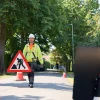VIDEO – Airband Tackles Most Challenging FTTP Broadband Build Ever

Rural broadband ISP Airband has announced that they’re currently tackling one of the “most challenging installations” of full fibre technology that they’ve “ever seen” in the historic North Devon (England) village of Clovelly, which sits perched on a cliff-top, complete with steep, narrow cobbled streets and 300 residents.
The build appears to form part of the provider’s existing contract with the Connecting Devon and Somerset (CDS) programme, which stems from their £25.5m state aid supported Phase 2 contract that will see them cover more than 40,000 premises with their full fibre network (here and here); this is currently expected to complete by the end of 2024.
However, some of the locations they need to tackle can be very difficult, and that’s certainly true of picturesque Clovelly. Originally owned by William the Conqueror, the estate of Clovelly remained in royal hands until 1242. It is now owned by John Rous who inherited it from his mother Mary Rous in 1983.
Advertisement
As you can imagine, deploying Fibre-to-the-Premises (FTTP) technology into such a location, where there is a need to preserve the environment and maintain the character of the area, is not an easy task. The fibre has had to be run up a steep 1.5km hill and Airband has had to carefully lift and correctly replace 12,000 street cobbles.
Since traditional machines can’t be used here, then they’ve had to use mechanical buckets for removing the spoil, meaning around 500 trips will have been made up and down the hill, totalling a massive 700 hours of work. Did we mention that almost every property is Grade 2 or 2* listed? This means that Airband has to follow strict restrictions to ensure that the historic character of the buildings are maintained.
Red Peel, Airband MD, said:
“At Airband we take pride in bringing connectivity to rural areas across the country. We’re especially proud to be working in partnership with the residents of the beautiful village of Clovelly – a truly one-of-a-kind area.
We’re thrilled to be offering superfast broadband to this area and providing residents and business owners with the many benefits which better connectivity brings, whilst also preserving the unique character of the environment which makes Clovelly so special. I think that this is perhaps the most challenging broadband installation we’ve ever undertaken.”
Councillor Rufus Gilbert said:
“Clovelly is a unique village in Devon and it’s exactly the kind of hard-to-reach area that the Connecting Devon and Somerset programme aims to connect with full fibre broadband. I’m proud that we’re working with Airband to help deliver better broadband to people in Clovelly – they need and deserve faster broadband speeds that are often taken for granted in urban areas. In rolling out full fibre to the entire community, every effort has been made by Airband to preserve the rich heritage of Clovelly’s cobbled streets. It has certainly made it a challenging project, especially when you take into account the steep terrain as well, but the team at Airband has risen to the challenge.”
The village previously only had access to much slower internet connectivity, and thus the arrival of FTTP will no doubt be seen as a very welcome boost. But sometimes it’s better to show than tell..
Advertisement
Mark is a professional technology writer, IT consultant and computer engineer from Dorset (England), he also founded ISPreview in 1999 and enjoys analysing the latest telecoms and broadband developments. Find me on X (Twitter), Mastodon, Facebook, BlueSky, Threads.net and Linkedin.
« Ofcom UK Delay Start of Openreach FTTP Broadband Price Cuts UPDATE3
Virgin Media O2 UK Finally Deploys 5G on London Underground »























































Nice, though I am maybe a little peeved that somewhere has benefited so massively from state aid just because it’s ‘pretty’….
Surely, in this type of environment, some form of wireless connection would be more suitable.
Fibre to an easy accessible local point then high speed wireless connection for the final connection to each premises.
There can be issues, when dealing with grade listed buildings, with putting visible infrastructure on the external side. Airband’s network is all underground.
Hi Mark, but surely high speed connections can be achieved without the need for antennas or dishes mounted on the outside of each property.
Generally, that’s how Fixed Wireless Access (FWA) broadband networks work. But you could, assuming the state aid existed to do it and a suitable site was found (very tricky in this area), potentially deploy a smaller OpenRAN style 5G mobile mast. Quite a few catches and unknowns with this approach though, especially in an area like that.
Mark, Airband do build overhead, too.
Good on them for not spoiling the environment, though sure they were made to by other parties as a condition.
They’d be waiting for ever if left to BT (and cue the BT fans rushing to defence).
Seriously though, they are lucky to get anyone give them coverage with fibre given the amount of work involved. Even I am more forgiving to BT in this respect.
Having stayed in Clovelly it’s good to see they are progressing.
Yes, the hill is steep and nicely cobbled over.
BUT, it still has the usual utilities like water supply and drainage.
So what happened to those old news reports that fibre can be channeled
through existing pipework and made to pop out in the closet?
Surely the local plumber would gladly welcome a challenge?
@Mike Good point.
Sending fibre through the water mains is still the subject of a fairly recent trial and won’t work everywhere, but we are expecting the results of that to surface very soon.
The idea for using mains water pipes is to get fibre into the area not to individual properties. It would too many exit points in the pipe for that.
Presumably these properties have phone lines already, so it would be interesting to know what Openreach’s infrastructure looks like around here – ducted? Direct-in-ground?
I guess no poles, but I see some building-to-building aerial connections around 2:48 in the video.
Unless they haven’t got permission from OR to use their ducts, I expect DIG.
I can imagine a lot of people with no full fibre options seeing the kind of work and expense going into this area and wondering why this is fine when they would cost way less and involve way less work.
Reminder both of what can be done, just about the cost, and that in some cases it’s very much a roll of the die.
In the video Tony is spot on. Copper isn’t fit for purpose. Anywhere in 2023.
Would be nice if the video had covered what they were doing in terms of siting splitters/CBTs. I presume on the cobbled hill they’ve run each cable individually back to a cabinet tucked out the way, a bit more detail than just “there’s a duct down the centre of the street” would have been appreciated.
The weirdest part of this video is the constant reference to future tense & “hope” clearly when filmed the service wasnt / isn’t live
Will those hopes be dashed? Looking at Airband reviews, quite probably